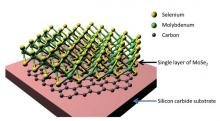Researchers from the SLAC lan in Stanford University developed a new method to make 2D material molybdenum diselenide or MoSe2 that has possible applications in photoelectronic devices, such as light detectors and solar cells, and perhaps also novel electronic devices.

This is the first time single-layer MoSe2 has been efficiently produced. The method they developed is based on molecular beam epitaxy, and starts with molybdenum and selenium, which are heated in a vacuum chamber until they evaporate. The two elements combined as a thin film. By tweaking the process, they managed to create thin films - one to eight atoms thick. Those sheets were grown on graphene substrates.
Source:
Posted: Jan 12,2014 by Ron Mertens